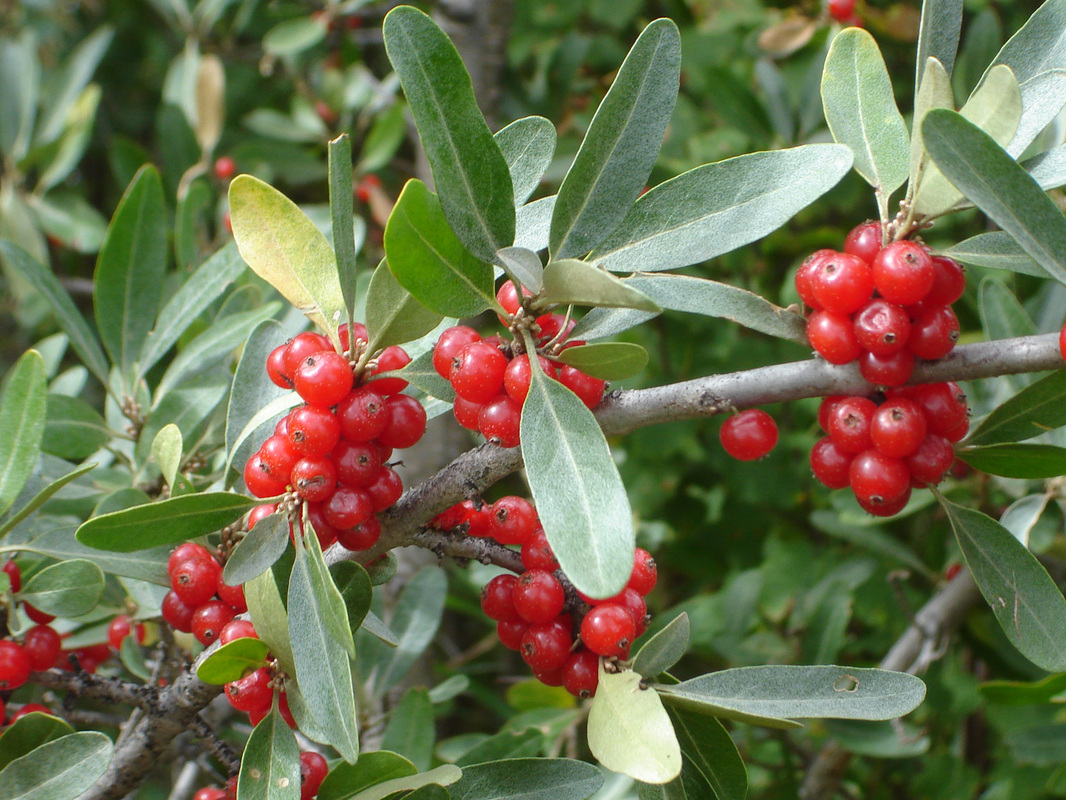|
Photo credit: SriMesh (Own work) [GFDL (http://www.gnu.org/copyleft/fdl.html) or CC BY-SA 3.0 (http://creativecommons.org/licenses/by-sa/3.0)], via Wikimedia Common
Study nature, love nature, stay close to nature. It will never fail you. Frank Lloyd Wright This fruiting tree like shrub is a member of the olive family( Elaegnaceae) and is known to be thicket forming . It can attain a height of one to six metres high with crown widths of five to six meters. It rarely reproduces by seed since its seeds have low viability, but it is known for its suckering ability. There are separate male and female plants and both are required for fruit development This plant is a particularly important winter food for wildlife due to the persistence of its fruits. The berries of this plant is one of the most important food source of the sharp tailed grouse over winter and in many places their survival over winter is dependant on these berries. (As well as sage, snowberry and rose) The flowers of silverberry appear early in spring and provide an early source of nectar and pollen for pollinators and bees during a time when floral resources are scarce. Therefore, silver buffalo berry plays an important role in the survival of bees and other pollinators. The young shoots are good browse for deer, rabbit and hare. Once it reaches two years old, it develops thorns which make it difficult to be browsed. The large thorns of this plant provide birds and other small animals with good cover and protection from predators, making it an ideal nesting site for song birds. It is also an important food for bears and elk. This shrub is capable of fixing nitrogen, so it enriches soil allowing more plants to grow. This ability to fix nitrogen allows it to grow in poor soil where other plants would not be able to. Because of its ability to tolerate salty soils, it was widely distributed and planted as a shelter belt tree by the PFRA. This tough plant is being studied and used for reclamation projects in soil contaminated by acid or heavy metals such as mined land. First Nations ate the berries fresh and used them for cooking into sauces and dried them for winter use and for some , it was a staple food. Some tribes added the berries into medicinal mixtures and used it as a laxative or for stomach troubles. The shredded bark was used for making laces When this plant grows on your land, it enriches you soil with nitrogen, it provides food for pollinators, ensuring the fertilization and productivity of your vegetables,seeds and fruits , as well providing food and shelter for a myriad of wildlife. So often we take for granted the marvels of the natural world. We really need to treasure and revere this plant for its importance in supporting the soil and the life that sustains us http://herb.umd.umich.edu/herb/search.pl?searchstring=Shepherdia+argentea http://www.prairie-elements.ca/buffaloberry.html http://www.nrcs.usda.gov/Internet/FSE_PLANTMATERIALS/publications/mtpmctn12232.pdf http://www.forthall.net/plants/silver_buffaloberry_shepherdia_a.htm http://en.wikipedia.org/wiki/Shepherdia_argentea
0 Comments
For in the true nature of things, if we rightly consider, every green tree is far more glorious than if it were made of gold and silver. ~ ~ Martin Luther King ~ When I stop to consider the amazing functions of trees, I can only agree with the opinions of tree lovers and permaculture practioners around the world, that most of the world's problems could be solved in a forest garden. How can trees repair our world? -trees provide food for us -trees provide us with renewable building materials -trees provide us with renewable fuel -trees provide us with life sustaining oxygen -trees protect the soil from erosion -trees provide homes and food for a myriad of insects, birds, and animals of all kinds - trees incorporate carbon dioxide acting as a carbon sink to mitigate global warming -tree transpire huge amounts of water vapour into the air important for producing clouds -clouds produced by trees provide rain for us -clouds made by trees reflect light away from the earth and help cool the earth preventing global warming -clouds provide shade and cooling during summer -trees prevent desertification by helping to produce clouds and rain,by cooling the ground during summer to prevent evaporation of water Lets celebrate and use nature's gift to us |
CategoriesAuthorManitoba is where I was born and where I have spent most of the five and one half decades of my life. I lived on the outskirts of the town of Portage La Prairie at a time when tadpoles and frogs inhabited the ditches and ponds, when there were many Monarch butterflies each summer along with dragon flies and grasshoppers. Redwing blackbirds perched the cattails of the ditches. As children we picked dandelions for bouquets and made wishes before blowing dandelion seed heads. We searched clover for lucky four leaves and rolled on the grass…there was no concern of poisonous herbicides. The grass was thick. Wherever we dug…there were earthworms Archives
September 2015
|
Photo used under Creative Commons from wackybadger

 RSS Feed
RSS Feed
